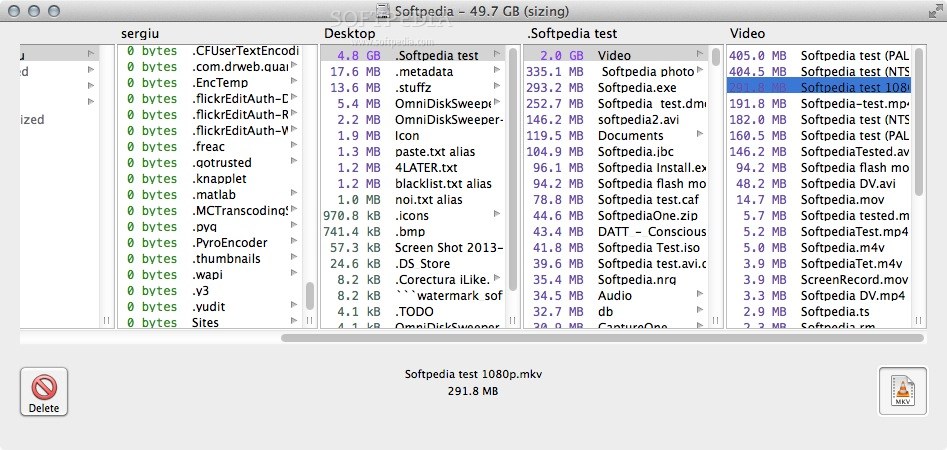
- #USE OMNIDISKSWEEPER HOW TO#
- #USE OMNIDISKSWEEPER MAC OS X#
- #USE OMNIDISKSWEEPER MAC OS#
- #USE OMNIDISKSWEEPER MANUAL#
Tap one to switch to Messages, tap the person’s avatar at the top of the conversation, tap the Info button, scroll down to see the photos, and tap See All Photos. In the iCloud Storage screen, tap Messages > Top Conversations to see which conversations are the largest. If you regularly trade photos and videos in chats, it could be another place you can save significant space. Investigate any apps reporting a lot of usage in the iCloud Storage screen, and if possible, clear out the unnecessary data.įinally, consider Messages. However, some other apps-think about third-party camera or video apps-may be using space unnecessarily.

#USE OMNIDISKSWEEPER MANUAL#
That will likely require lots of manual effort. The Photos app will likely be using the most storage, but all you can do to minimize its space usage is delete unnecessary screenshots, duplicate photos, and accidental videos from Photos. While you’re in the iCloud Storage screen (the leftmost screenshot above), look through the other apps at the top of the list. Happily, Apple alerts you when you’re running low on space, before things get bad. Email to your iCloud email address will be rejected, photos won’t upload from your iPhone, and app data will fail to sync. That said, you don’t want to run out of storage space. But if you’re paying $2.99 per month and nudge up against the 200 GB limit, you may not be enthused about increasing your payment to $9.99 per month when you’re unlikely to need anywhere near 2 TB. The latter two plans can even be shared with others in your Family Sharing group.Īs we’ve noted elsewhere, using iCloud Photos almost certainly requires you to pay for extra storage. $0.99 per month gets you 50 GB, $2.99 per month provides 200 GB, and for $9.99 per month, you can use a whopping 2 TB. That disappears quickly, given how it’s shared between iCloud Mail, iCloud Drive, iCloud Photos, Messages, and iCloud-enabled apps.Īpple will, of course, sell you more iCloud space. Our Contact: Kindly use our contact page regards any help.By default, Apple gives every iCloud user 5 GB of storage space.
#USE OMNIDISKSWEEPER HOW TO#
Want to add an alternate method: If anyone wants to add more methods to the guide How to Recover Hard Disk Space on Mac with OmniDiskSweeper, then kindly contact us. Misinformation: If you want to correct any misinformation about the guide “How to Recover Hard Disk Space on Mac with OmniDiskSweeper”, then kindly contact us. If you have any queries regards the How to Recover Hard Disk Space on Mac with OmniDiskSweeper, then please ask us through the comment section below or directly contact us.Įducation: This guide or tutorial is just for educational purposes. In this guide, I discuss about the How to Recover Hard Disk Space on Mac with OmniDiskSweeper, which is very helpful.įinal note: How to Recover Hard Disk Space on Mac with OmniDiskSweeper In this guide, I told you about the How to Recover Hard Disk Space on Mac with OmniDiskSweeper.
#USE OMNIDISKSWEEPER MAC OS#
It is important that you understand exactly what you are seeing and what it is for, as removing the wrong thing can corrupt the Mac OS software or lead to the unintentional loss of critical data or personal files.įAQ: How to Recover Hard Disk Space on Mac with OmniDiskSweeper

Often you will find very large files or folders that you have already forgotten, using tools like OmniDiskSweeper, and of course also caches and temp files will be displayed, as well as personal files and data.

#USE OMNIDISKSWEEPER MAC OS X#

User ~ / Library / Application Support / Directory contained 1GB files for applications no longer used.For example, by swiping a drive with OmniDiskSweeper, I noticed and removed the following items: What can be removed varies by user, drive, and Mac, but everyone is sure to find supplies that no longer need to be stored.


 0 kommentar(er)
0 kommentar(er)
